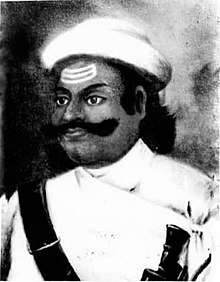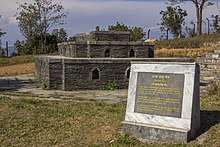Kalu Pande
Vamshidhar Pande (Nepali: वंशीधर पाँडे) known by sobriquet Kalu Pande (Nepali: कालु पाँडे) was a Nepalese politician and military general who was appointed as Kaji of The Gorkha Kingdom. He was born in 1713 A.D in Gorkha. . He was the commander of the Gorkhali forces during the Expansion Campaign of Nepal. He died in the first Battle of Kirtipur in 1757 A.D. His real name was Banshidhar Pande. He was a son of Kaji Bhimraj Pande who was minister during reign of King Prithivipati Shah of Gorkha. He was descendant of Minister of Gorkha and Dravya Shah's accomplice Ganesh Pande. He had three sons: Dewan Kajisaheb Vamsharaj Pande, Sardar Ranasur Pande and Mulkaji Sahib Damodar Pande (1st PM of Nepal).[1]
Vamshidhar "Kalu" Pande | |
|---|---|
श्री काजी वंशीधर "कालु" पाँडे | |
 Kaji Kalu Pandey of Gorkha Kingdom | |
| Chief of the Nepalese Army | |
| In office ca. 1746 - 1757 | |
| Preceded by | Prithvi Narayan Shah |
| Succeeded by | Vamsharaj Pande, Abhiman Singh Basnet |
| Personal details | |
| Born | Vamshidhar Pande 1713 A.D. Gorkha Kingdom (present day Gorkha District, Nepal) |
| Died | 1757 A.D. (aged 43-44) Tyanglaphant Kirtipur, Kirtipur Kingdom (present day Kathmandu District, Nepal) |
| Nationality | Nepali |
| Children | Vamsharaj Pande, Ranashur Pande, Damodar Pande |
| Father | Kaji Bhimraj Pande |
| Relatives | Pande dynasty Basnyat family |
| Military service | |
| Battles/wars | Battle of Kirtipur, Unification of Nepal |
Career
Kalu Pande was made the Commander-in-Chief of the Gorkhali Army after Biraj Thapa Magar and his first major Battle was the Battle of Kirtipur. Despite his initial resentment to the fact that the valley kings were well prepared and the Gorkhalis were not, Pande gave a 'Yes' to the operation, due to being insisted by Prithvi Narayan Shah. The Gorkhalis had set up a base on Naikap, a hill on the valley's western rim, from where they were to mount their assaults on Kirtipur. They were armed with swords, bows and arrows and muskets.[2]
The Valley Kings brought a large number of Doyas from Indian Plains under Shaktiballabh sardar. During the first assault in 1757, the Gorkhali army killed 1200 enemies, mostly Doyas, but were badly beaten themselves. Both sides suffered heavy losses. As they advanced towards Kirtipur, the combined force of Valley Kings under Kaji Gangadhar Jha, Kaji Gangaram Thapa and Sardar Shaktiballabh brought Havoc to the outnumbered Gorkhalis. The two forces fought on the plain of Tyangla Phant in the northwest of Kirtipur. Surapratap Shah, the King's brother lost his right eye to an arrow while scaling the city wall. The Gorkhali commander Kaji Kalu Pande was surrounded and killed, and the Gorkhali king himself narrowly escaped with his life into the surrounding hills disguised as a saint.[3][4]
King's disheartenment
King Prithvi Narayan Shah's letter to Sardar Ramakrishna Kunwar mentioned by historian Baburam Acharya quotes disheartenment of King Prithvi over death of Kalu Pande: "When Kalu Pande was killed in Kirtipur, I had felt disheartened, thinking that I had not been able to conquer the three towns of Nepal..."[5]
Gallery
 Bamshidhar Kalu Pande
Bamshidhar Kalu Pande Kalu Pande
Kalu Pande unification during battle field
unification during battle field Memorial where Kalu Pande was assassinated in 1814 B.S.
Memorial where Kalu Pande was assassinated in 1814 B.S.
References
- http://knownepalshistory.blogspot.com/2015/10/kaji-kalu-pandey-great-warrior.html?m=1
- Vansittart, Eden (1896). Notes on Nepal. Asian Educational Services. ISBN 978-81-206-0774-3. Page 34.
- Majupuria, Trilok Chandra (March 2011). "Kirtipur: The Ancient Town on the Hill". Nepal Traveller. Archived from the original on 17 November 2015. Retrieved 18 October 2012.
- Wright, Daniel (1990). History of Nepal. New Delhi: Asian Educational Services. Retrieved 7 November 2012. Page 227.
- Acharya 1950, p. 95.